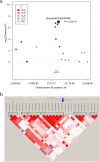Genome wide association study identifies SNPs associated with fatty acid composition in Chinese Wagyu cattle
- PMID: 30867906
- PMCID: PMC6399853
- DOI: 10.1186/s40104-019-0322-0
Genome wide association study identifies SNPs associated with fatty acid composition in Chinese Wagyu cattle
Abstract
Background: Fatty acids are important traits that affect meat quality and nutritive values in beef cattle. Detection of genetic variants for fatty acid composition can help to elucidate the genetic mechanism underpinning these traits and promote the improvement of fatty acid profiles. In this study, we performed a genome-wide association study (GWAS) on fatty acid composition using high-density single nucleotide polymorphism (SNP) arrays in Chinese Wagyu cattle.
Results: In total, we detected 15 and 8 significant genome-wide SNPs for individual fatty acids and fatty acid groups in Chinese Wagyu cattle, respectively. Also, we identified nine candidate genes based on 100 kb regions around associated SNPs. Four SNPs significantly associated with C14:1 cis-9 were embedded with stearoyl-CoA desaturase (SCD), while three SNPs in total were identified for C22:6 n-3 within Phospholipid scramblase family member 5 (PLSCR5), Cytoplasmic linker associated protein 1 (CLASP1), and Chymosin (CYM). Notably, we found the top candidate SNP within SCD can explain ~ 7.37% of phenotypic variance for C14:1 cis-9. Moreover, we detected several blocks with high LD in the 100 kb region around SCD. In addition, we found three significant SNPs within a 100 kb region showing pleiotropic effects related to multiple FA groups (PUFA, n-6, and PUFA/SFA), which contains BAI1 associated protein 2 like 2 (BAIAP2L2), MAF bZIP transcription factor F (MAFF), and transmembrane protein 184B (TMEM184B).
Conclusions: Our study identified several significant SNPs and candidate genes for individual fatty acids and fatty acid groups in Chinese Wagyu cattle, and these findings will further assist the design of breeding programs for meat quality in cattle.
Keywords: Chinese Wagyu cattle; Fatty acids; GWAS; Meat quality; Pleiotropic effects.
Conflict of interest statement
Animal experiments were approved by the Science Research Department of the Institute of Animal Sciences, Chinese Academy of Agricultural Sciences (CAAS) (Beijing, China). There was no use of human participants, data or tissues.Not applicable.The authors declare that they have no competing interests.
Figures




Similar articles
-
A post-GWAS confirming the SCD gene associated with milk medium- and long-chain unsaturated fatty acids in Chinese Holstein population.Anim Genet. 2016 Aug;47(4):483-90. doi: 10.1111/age.12432. Epub 2016 Mar 11. Anim Genet. 2016. PMID: 26970560
-
Genome-wide association study and prediction of genomic breeding values for fatty-acid composition in Korean Hanwoo cattle using a high-density single-nucleotide polymorphism array.J Anim Sci. 2018 Sep 29;96(10):4063-4075. doi: 10.1093/jas/sky280. J Anim Sci. 2018. PMID: 30265318 Free PMC article.
-
Genome-wide association study for fatty acid composition in Japanese Black cattle.Anim Sci J. 2013 Oct;84(10):675-82. doi: 10.1111/asj.12063. Epub 2013 Apr 8. Anim Sci J. 2013. PMID: 23607548
-
Genome wide association study and genomic prediction for fatty acid composition in Chinese Simmental beef cattle using high density SNP array.BMC Genomics. 2017 Jun 14;18(1):464. doi: 10.1186/s12864-017-3847-7. BMC Genomics. 2017. PMID: 28615065 Free PMC article.
-
Identification and utilization of genes associated with beef qualities.Anim Sci J. 2011 Feb;82(1):1-7. doi: 10.1111/j.1740-0929.2010.00845.x. Anim Sci J. 2011. PMID: 21269353 Review.
Cited by
-
Genome-wide association analysis revealed novel candidate genes for body measurement traits in indigenous Gudali and crossbred Simgud in Cameroon.BMC Genomics. 2025 Jul 14;26(1):664. doi: 10.1186/s12864-025-11865-7. BMC Genomics. 2025. PMID: 40660125 Free PMC article.
-
Genome-Wide Association Study for Fatty Acid Composition in American Angus Cattle.Animals (Basel). 2021 Aug 18;11(8):2424. doi: 10.3390/ani11082424. Animals (Basel). 2021. PMID: 34438882 Free PMC article.
-
Lipidomics and Transcriptome Reveal the Effects of Feeding Systems on Fatty Acids in Yak's Meat.Foods. 2022 Aug 26;11(17):2582. doi: 10.3390/foods11172582. Foods. 2022. PMID: 36076769 Free PMC article.
-
Novel Genomic Regions Associated with Intramuscular Fatty Acid Composition in Rabbits.Animals (Basel). 2020 Nov 11;10(11):2090. doi: 10.3390/ani10112090. Animals (Basel). 2020. PMID: 33187110 Free PMC article.
-
The Genetic Characteristics of FT-MIRS-Predicted Milk Fatty Acids in Chinese Holstein Cows.Animals (Basel). 2024 Oct 8;14(19):2901. doi: 10.3390/ani14192901. Animals (Basel). 2024. PMID: 39409850 Free PMC article.
References
LinkOut - more resources
Full Text Sources
Other Literature Sources
Molecular Biology Databases
Research Materials

